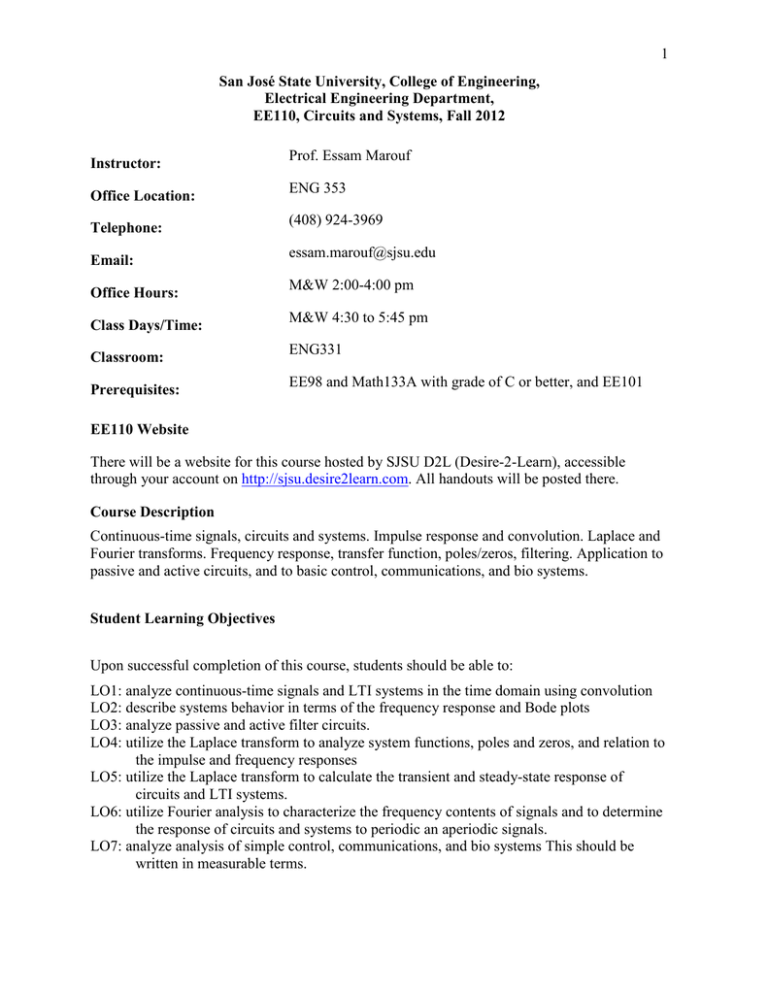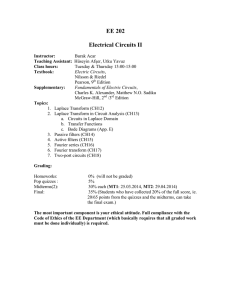
1
San José State University, College of Engineering,
Electrical Engineering Department,
EE110, Circuits and Systems, Fall 2012
Instructor:
Office Location:
Telephone:
Email:
Office Hours:
Class Days/Time:
Classroom:
Prerequisites:
Prof. Essam Marouf
ENG 353
(408) 924-3969
essam.marouf@sjsu.edu
M&W 2:00-4:00 pm
M&W 4:30 to 5:45 pm
ENG331
EE98 and Math133A with grade of C or better, and EE101
EE110 Website
There will be a website for this course hosted by SJSU D2L (Desire-2-Learn), accessible
through your account on http://sjsu.desire2learn.com. All handouts will be posted there.
Course Description
Continuous-time signals, circuits and systems. Impulse response and convolution. Laplace and
Fourier transforms. Frequency response, transfer function, poles/zeros, filtering. Application to
passive and active circuits, and to basic control, communications, and bio systems.
Student Learning Objectives
Upon successful completion of this course, students should be able to:
LO1: analyze continuous-time signals and LTI systems in the time domain using convolution
LO2: describe systems behavior in terms of the frequency response and Bode plots
LO3: analyze passive and active filter circuits.
LO4: utilize the Laplace transform to analyze system functions, poles and zeros, and relation to
the impulse and frequency responses
LO5: utilize the Laplace transform to calculate the transient and steady-state response of
circuits and LTI systems.
LO6: utilize Fourier analysis to characterize the frequency contents of signals and to determine
the response of circuits and systems to periodic an aperiodic signals.
LO7: analyze analysis of simple control, communications, and bio systems This should be
written in measurable terms.
2
EE110, Circuits and Systems, Fall 2012
Required & Recommended Texts/Software
1) F. Ulaby and A. Yagle,Engineering Signals and Systems, NTS Press, 2012. Required.
2) Selected slides from an online course covering similar material (highly recommended)
- MIT OpenCourseWare (OCW) 6.003, Signals and Systems, Spring 2010
(http://ocw.mit.edu/courses/electrical-engineering-and-computer-science/6-003-signals-andsystems-spring-2010/)
3) No software is required (may change in the future). Matlab may be used for in-class demos.
Other References
1. Oppenheim, Willsky, and Nawab, Signals and Systems, 2nd Ed., Pearson/Prentice-Hall, 1997.
2. F. Ulaby and M. Maharbiz, Circuits, NTS Press, 2010
3. R. Dorf and J. Svoboda, Introduction to Electric Circuits, 8th Ed., John Wiley, 2010
Dropping and Adding
Students are responsible for understanding the policies and procedures about add/drop, grade
forgiveness, etc. Refer to the current semester’s Catalog Policies section at
http://info.sjsu.edu/static/catalog/policies.html. Add/drop deadlines can be found on the current
academic calendar web page located at
http://www.sjsu.edu/academic_programs/calendars/academic_calendar/. The Late Drop Policy
is available at http://www.sjsu.edu/aars/policies/latedrops/policy/. Students should be aware of
the current deadlines and penalties for dropping classes.
Information about the latest changes and news is available at the Advising Hub at
http://www.sjsu.edu/advising/.
Assignments and Grading Policy
Grading:
Homework/Quizzes
Midterm Exam #1: (Mon 10/01/12, 4:30-5:45 pm)
Midterm Exam #2: (Wed 11/14/12, 4:30-5:45 pm)
Final Exam
: (Tue 12/18/12, 2:45-5:00 pm)
10%
25%
25%
40%
Exams:
All exams are in-class, closed book and notes. Two 8.5x11 front & back summary sheets in
your own hand writing are allowed. No other blank papers, photocopied problem solutions, or
any other course material is allowed.
Homework:
Homework is crucial for understanding the course material. Homework will be assigned regularly and
will be collected. The homework will be assessed either by directly grading the homework, or by short
EE110, Circuits and Systems, Fall 2012
3
quiz based on the homework problems given at the beginning of the lecture, or both. Solutions will be
provided. You’re welcome (and encouraged) to discuss homework problems with other students in the
class but you have to submit your own independent solutions. Copied homework earn zero grade for
all parties involved and could have more serious consequences.
Numerical Grade to Letter Grade Conversion:
95% and above
90-94%
86-89%
82-85%
78-81%
74-77%
70-73%
66-69%
62-65%
58-61%
54-57%
50-53%
below 50%
A+,
A
AB+
B
BC+
C
CD+
D
DF
University Policies
Academic integrity
Your commitment as a student to learning is evidenced by your enrollment at San Jose State
University. The University’s Academic Integrity policy, located at
http://www.sjsu.edu/senate/S07-2.htm, requires you to be honest in all your academic course
work. Faculty members are required to report all infractions to the office of Student Conduct
and Ethical Development. The Student Conduct and Ethical Development website is available
at http://www.sa.sjsu.edu/judicial_affairs/index.html.
Instances of academic dishonesty will not be tolerated. Cheating on exams or plagiarism
(presenting the work of another as your own, or the use of another person’s ideas without
giving proper credit) will result in a failing grade and sanctions by the University. For this
class, all assignments are to be completed by the individual student unless otherwise specified.
If you would like to include your assignment or any material you have submitted, or plan to
submit for another class, please note that SJSU’s Academic Policy S07-2 requires approval of
instructors.
Campus Policy in Compliance with the American Disabilities Act
If you need course adaptations or accommodations because of a disability, or if you need to
make special arrangements in case the building must be evacuated, please make an appointment
with me as soon as possible, or see me during office hours. Presidential Directive 97-03
requires that students with disabilities requesting accommodations must register with the
EE110, Circuits and Systems, Fall 2012
4
Disability Resource Center (DRC) at http://www.drc.sjsu.edu/ to establish a record of their
disability.
EE Department Honor Code
The Electrical Engineering Department will enforce the following Honor Code that must be
read and accepted by all students.
“I have read the Honor Code and agree with its provisions. My continued enrollment in this
course constitutes full acceptance of this code. I will NOT:
•
•
•
•
•
•
Take an exam in place of someone else, or have someone take an exam in my place
Give information or receive information from another person during an exam
Use more reference material during an exam than is allowed by the instructor
Obtain a copy of an exam prior to the time it is given
Alter an exam after it has been graded and then return it to the instructor for re-grading
Leave the exam room without returning the exam to the instructor.”
Measures Dealing with Occurrences of Cheating
•
•
Department policy mandates that the student or students involved in cheating will
receive an “F” on that evaluation instrument (paper, exam, project, homework, etc.)
and will be reported to the Department and the University.
A student’s second offense in any course will result in a Department recommendation of
suspension from the University.
IMPORTANT NOTE: FRIDAY LECTURES
In addition to my teaching duties, I am also involved in research projects related to planetary
exploration by unmanned spacecraft. To be able to attend related technical meetings and
conferences during the semester, some rescheduling of class time will be necessary. During
one or more weeks of the semester the class may be taught M & F, W & F, or M & W & F to
compensate for any sessions missed during travel. Please make sure that you are available to
attend the lecture on Friday (4:30-5:45 pm), in addition to the regular times on M & W. Any
Friday lectures will be announced in class ahead of time.
5
EE110, Circuits and Systems, Fall 2012
EE110, Circuits and Systems, Fall 2012
Tentative Class Schedule
Week
Day
1
W 8/22
2
M 8/27
W 8/29
3
M 9/3
W 9/5
Lecture Topics
Reading Assignment
Ulaby-Yagle Text
Class organization
Signal types, transformations, and properties
1-1 - 1-3
Non-periodic signals. Signal power & energy.
LTI systems. Impulse response.
1-4, 1-5
2-1 - 2-2
Labor Day - Campus Closed
Convolution. Analytical & graphical evaluation.
2-3 - 2-4
4
M 9/10
W 9/12
Convolution properties. Causality & stability.
Frequency response. Passive RL/RC filtering; Bode plots-1
2-5 - 2-6
2-7, 6-1
5
M 9/17
W 9/19
Passive RLC filtering: tuned circuits, BSF; Bode plots-2
Bode plots-3 : additional examples
6-2
Bode Plots Handout
6
M 9/24
W 9/26
Active filters. Bio-system example
Laplace transform. Properties & example pairs-1
6-3
3-1 - 3-3
7
M 10/1
W 10/3
MT #1 (covers material up to M 9/24 lecture)
Properties & example pairs-2; circuits example
3-3 - 3-4
8
M 10/8
W 10/10
Inverse Laplace transform using PFE
Transfer function. Poles & stability. Invertability.
3-4 - 3-5
3-6 - 3-8
9
M 10/15
W 10/19
Transient/Steady-State, forced/natural responses
s-domain circuit analysis; mechanical analogs
3-10 - 3-11
4-1 - 4-4
10
M 10/22
W 10/24
Op-amp circuits. Systems from subsystems. Realizations.
Basic control theory. Temperature control example.
4-5 - 4-7
4-8 - 4-9
11
M 10/29
Amplifier gain-bandwidth product. Motor step
response
4-10 - 4-11
W 10/31
Fourier series and why? Fourier series coefficients-1
5-1 - 5-4.1
Fourier series coefficients-2.
Circuit analysis with the Fourier series.
5-4.2 - 5-4.5
5-5 - 5-6
12
M 11/5
W 11/7
13
M 11/12
W 11/14
Veteran's Day - Campus Closed
MT2 (covers material up to W 11/7 lecture)
14
M 11/19
W 11/21
The Fourier Transform. Example Fourier pairs.
Transform Properties. More example pairs.
5-7 - 5-8.5
5-8.6to7, 5-9, 5-10
15
M 11/26
H(w) from poles/zeros of H(s). Frequency rejection filters.
6-4 - 6-6
EE110, Circuits and Systems, Fall 2012
W 11/28
6
Example: de-noising of a musical signal
6-7 - 6-9
Amplitude modulation
Mixing. Superhetrodyne receiver. Multiplexing.
6-11.1 - 6-11.5
6-11.6 - 6-11.8
16
M 12/3
W 12/5
17
M 12/10
W 12/12
Review
M12/18
Final Exam (Tue 12/18/12, 2:45-5:00 pm)



